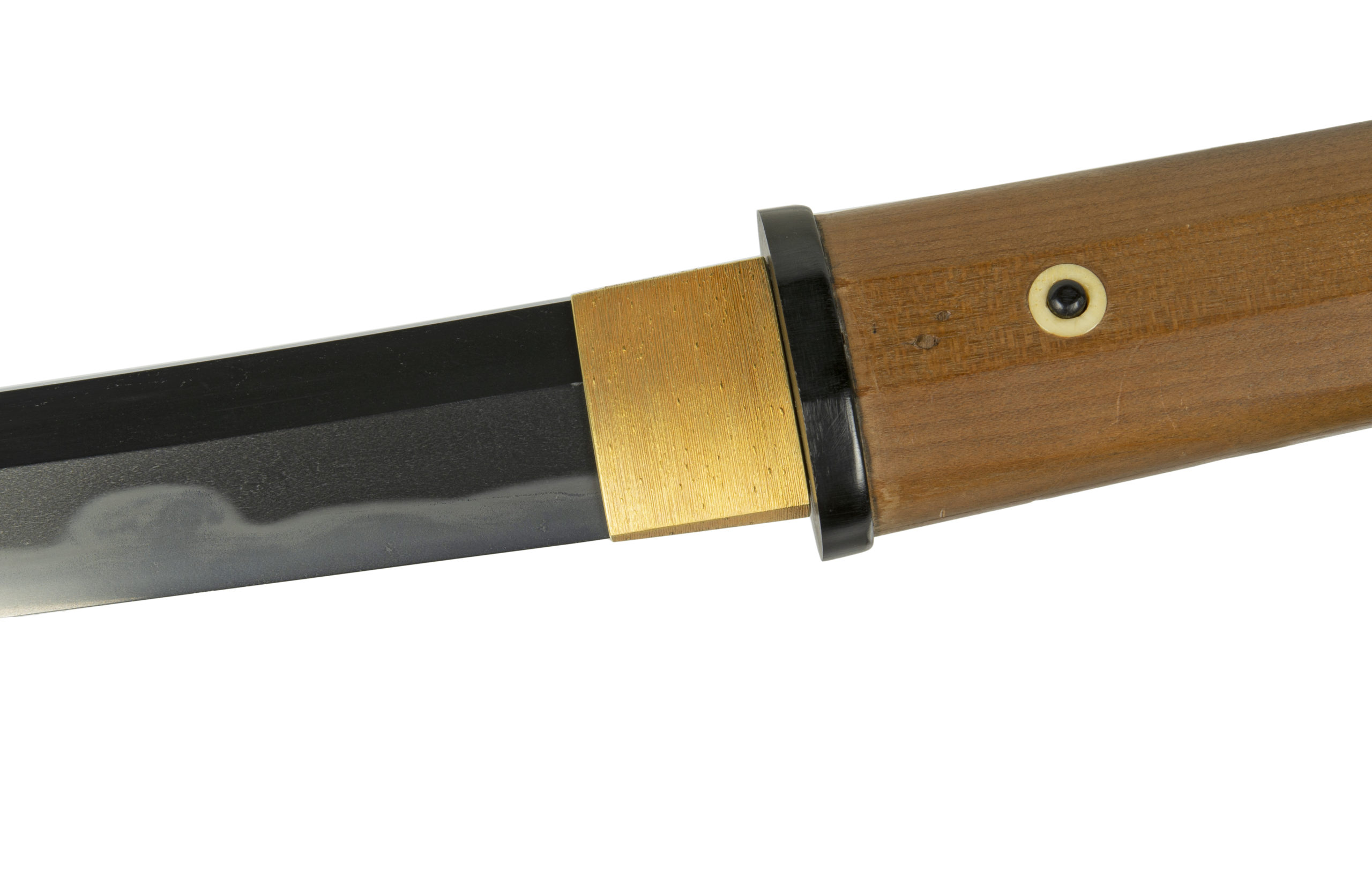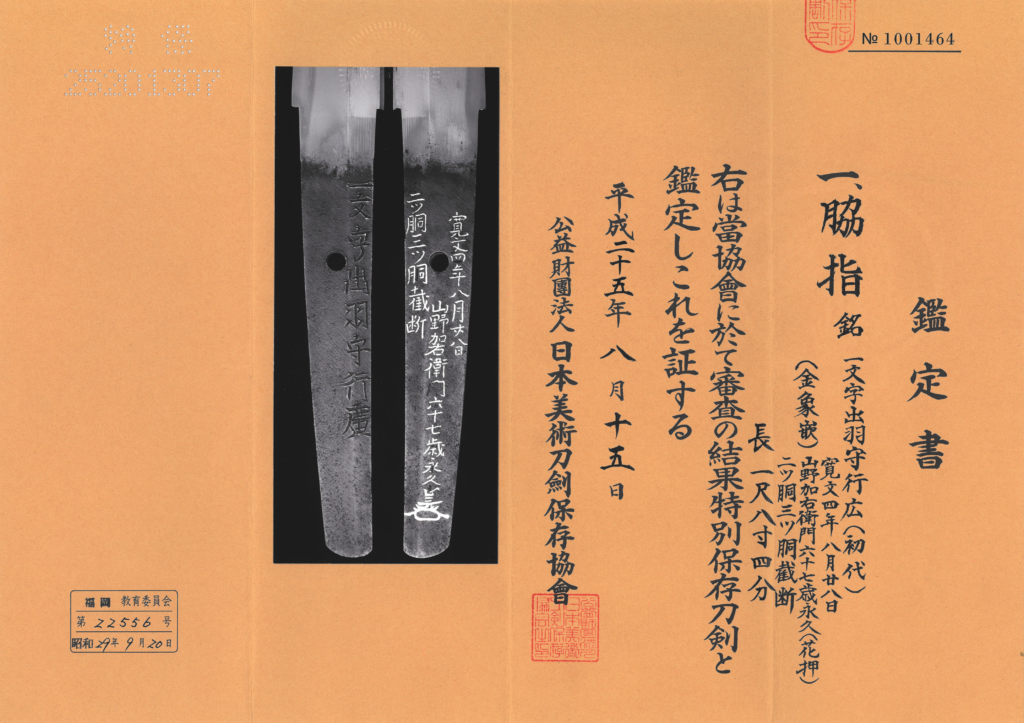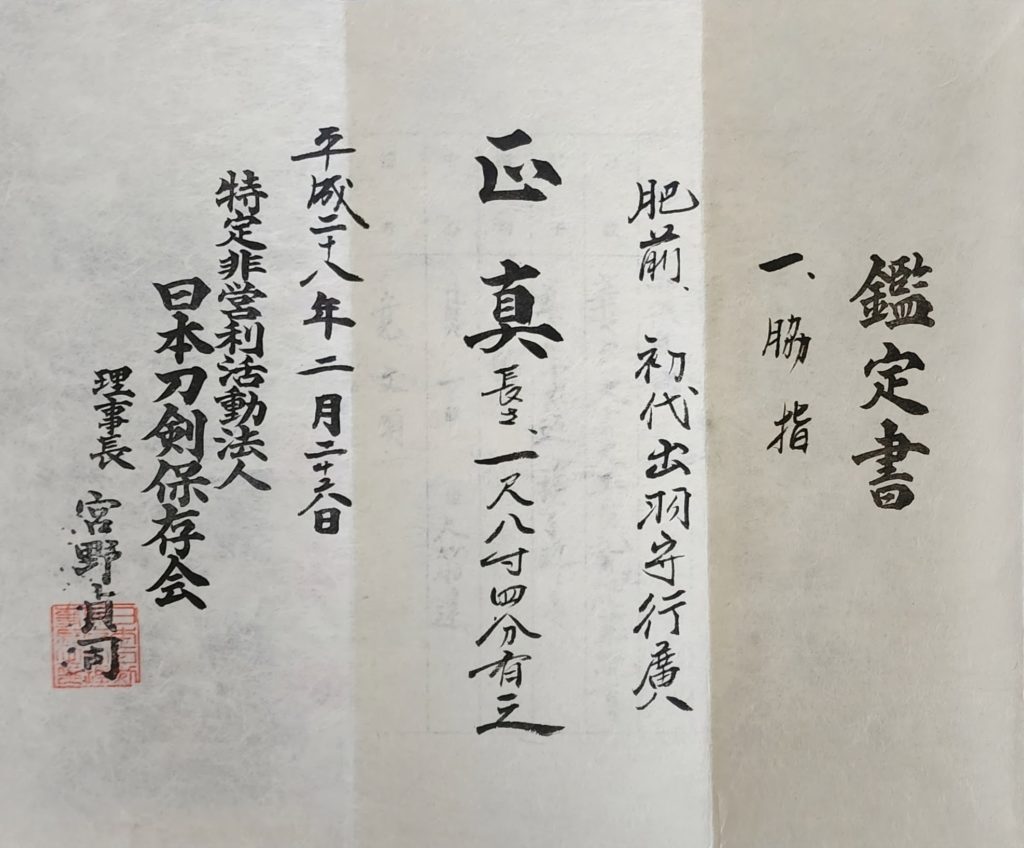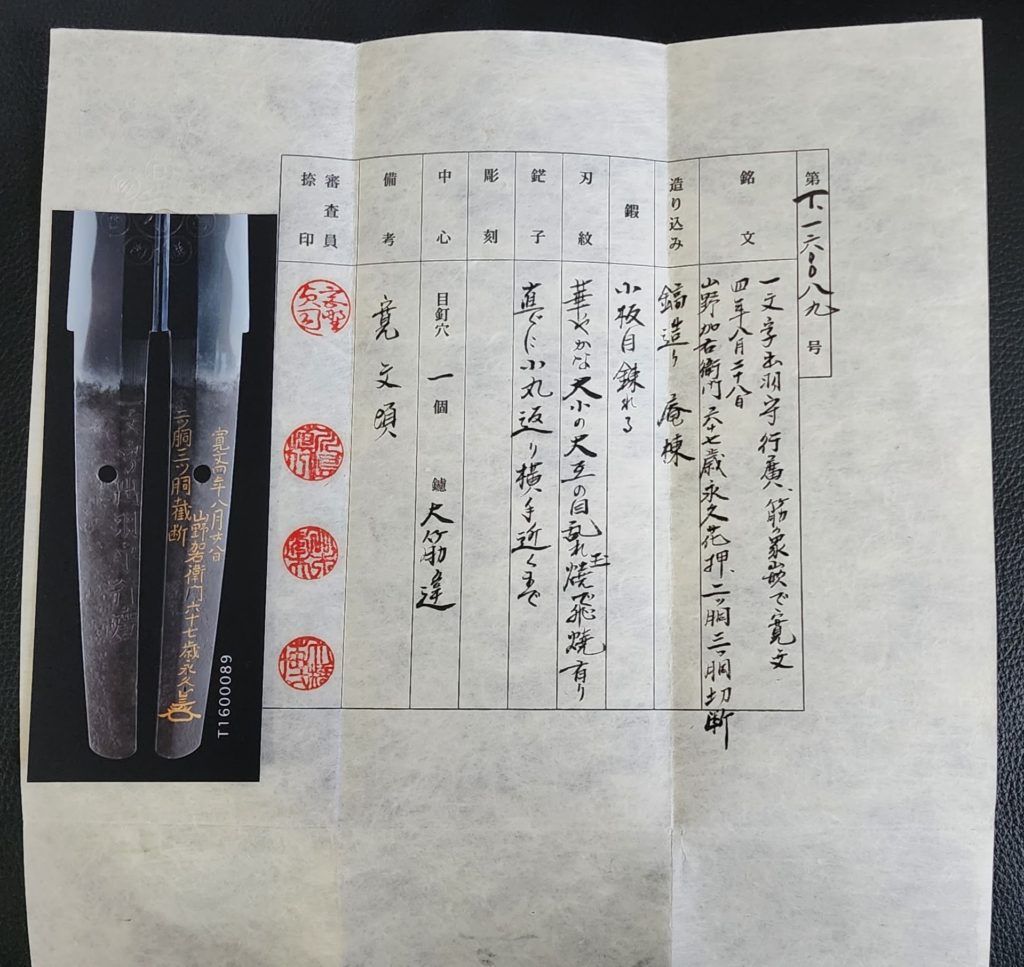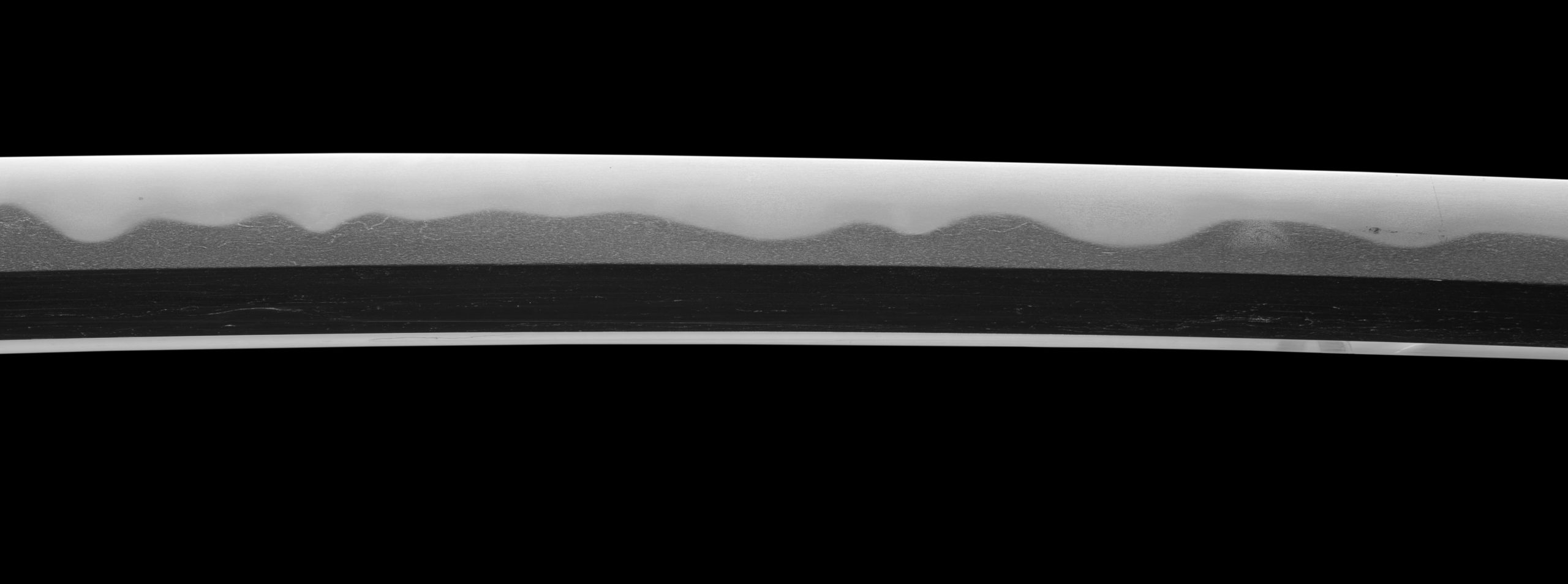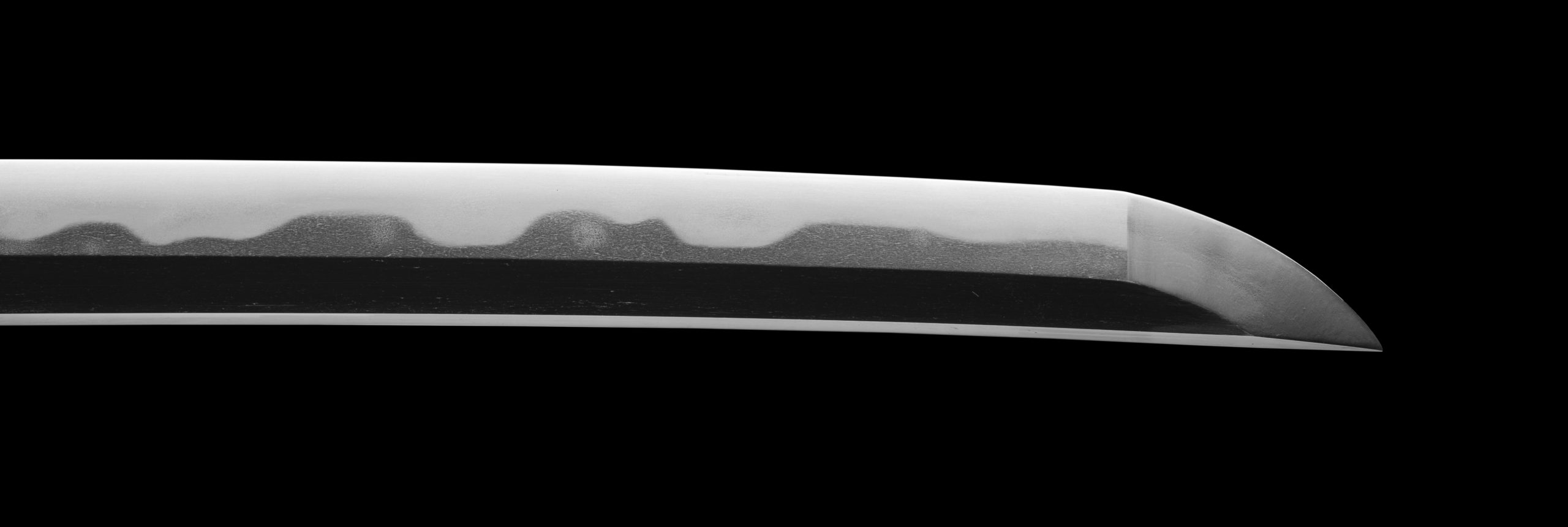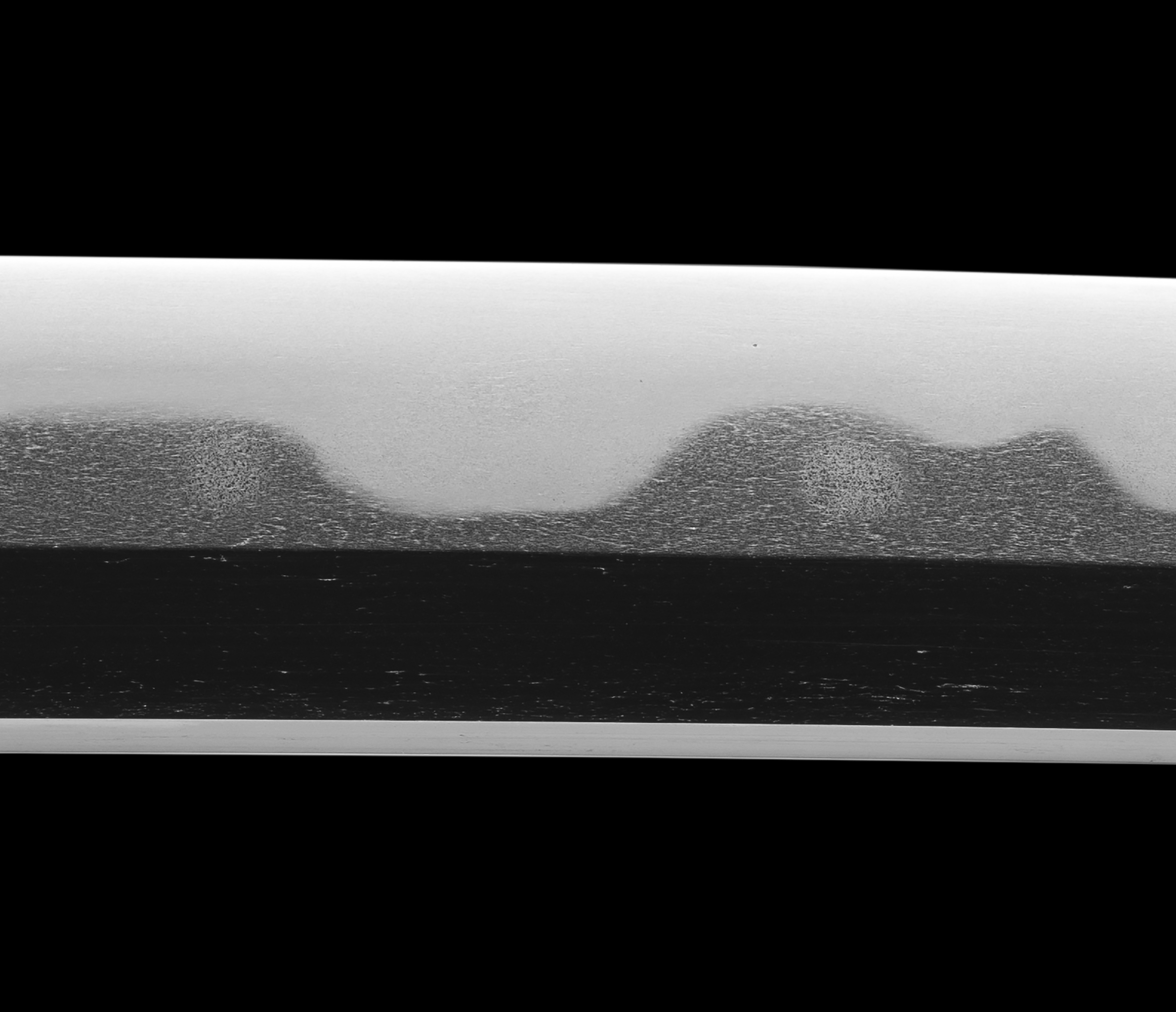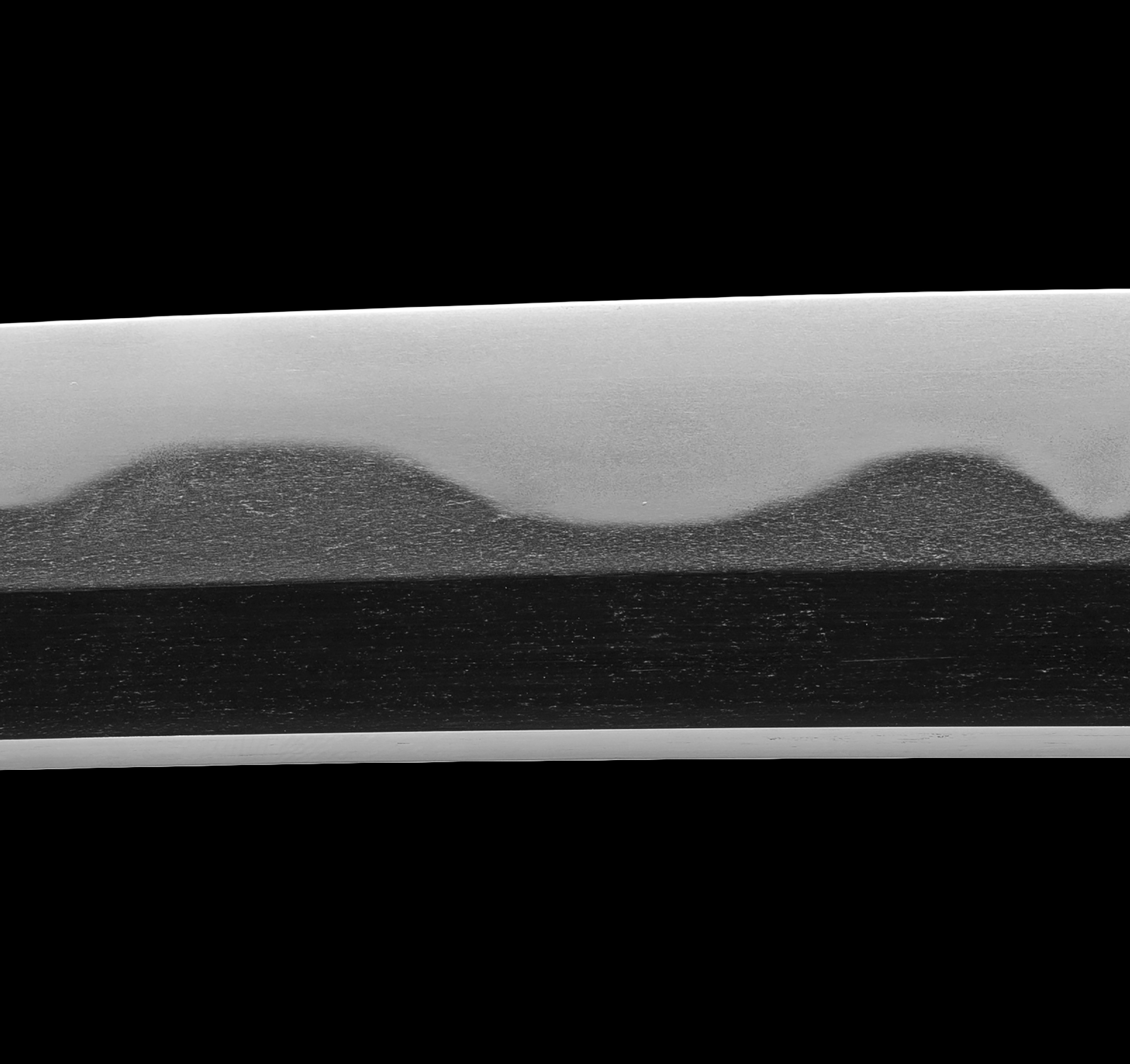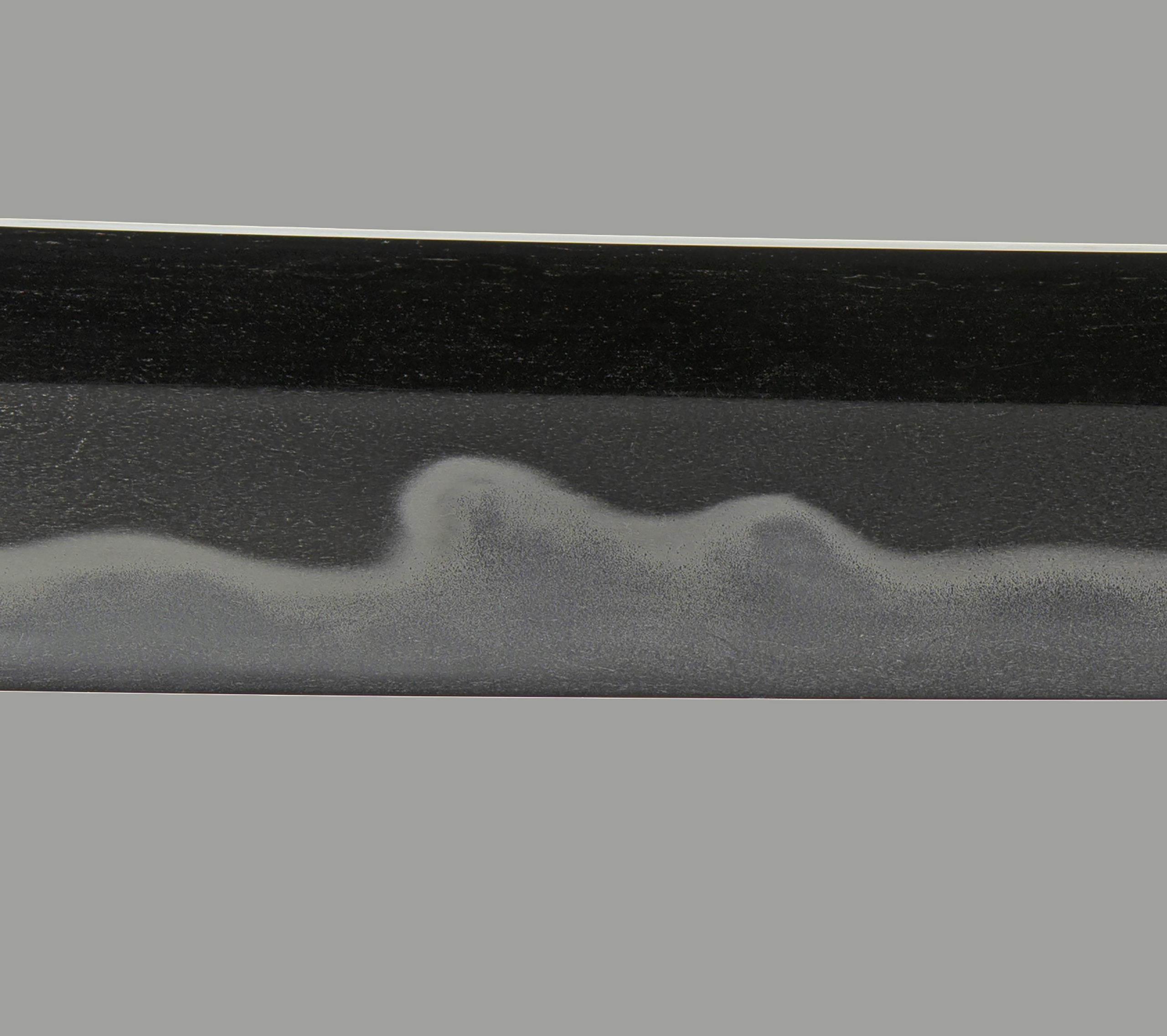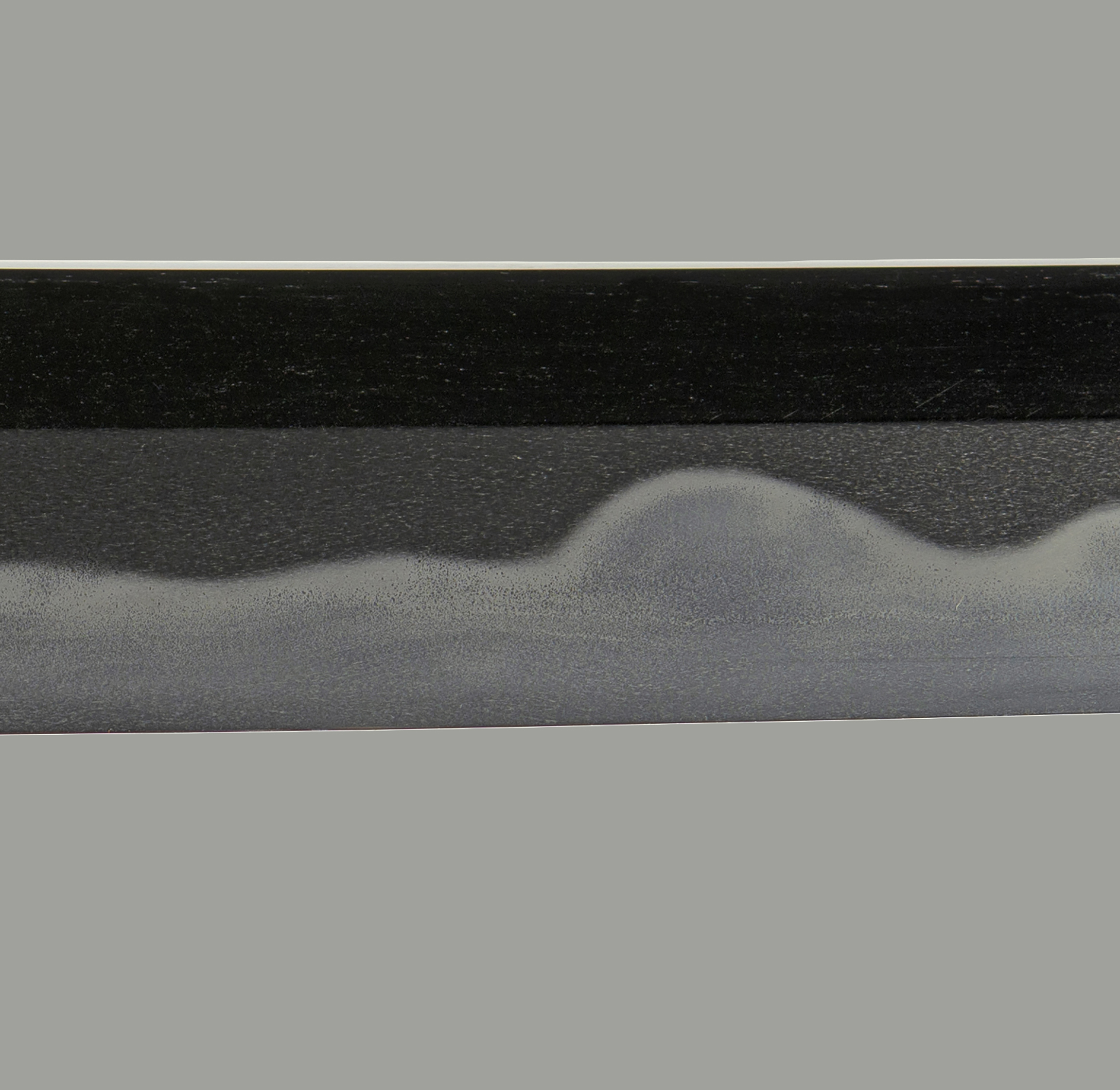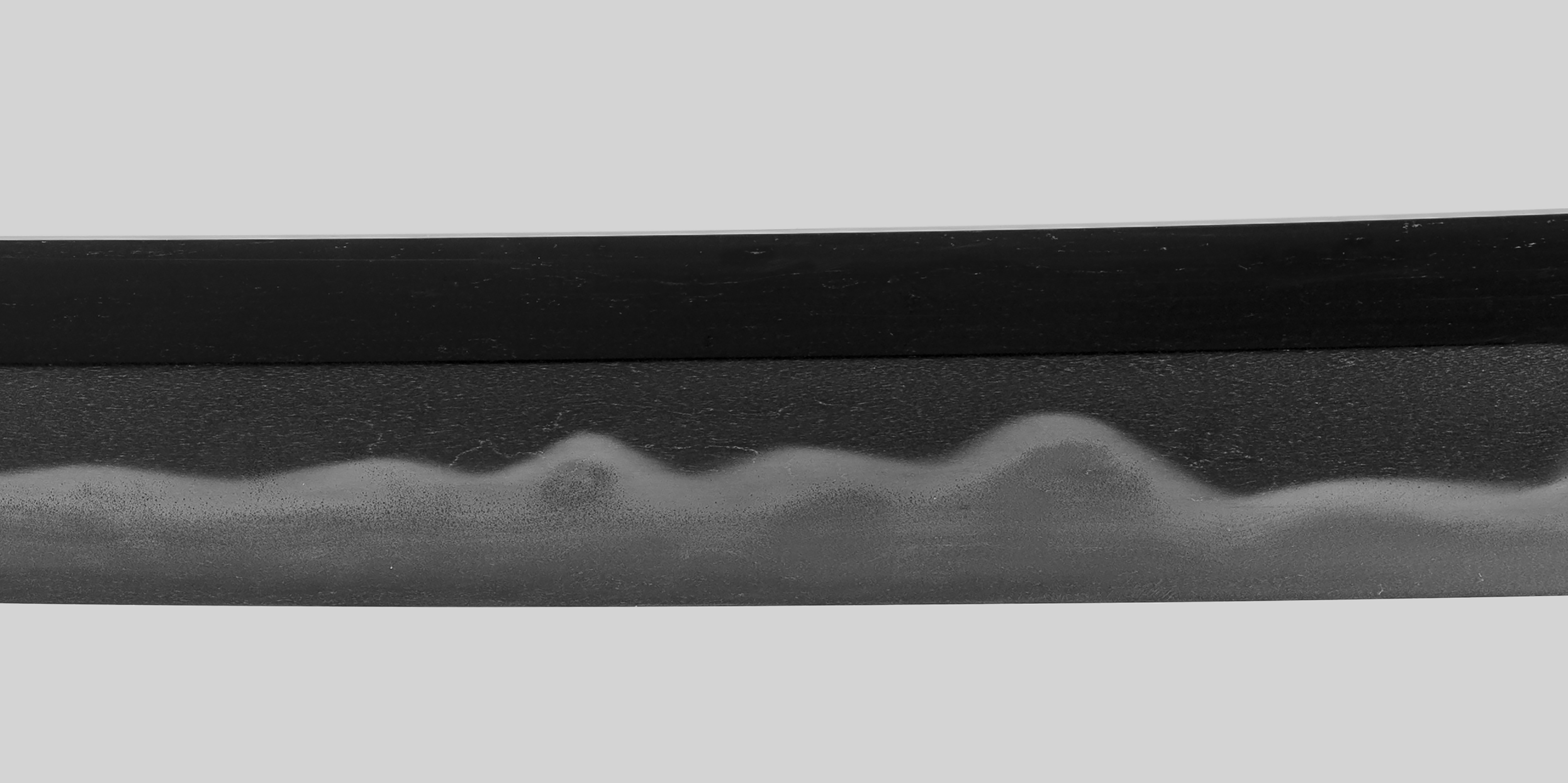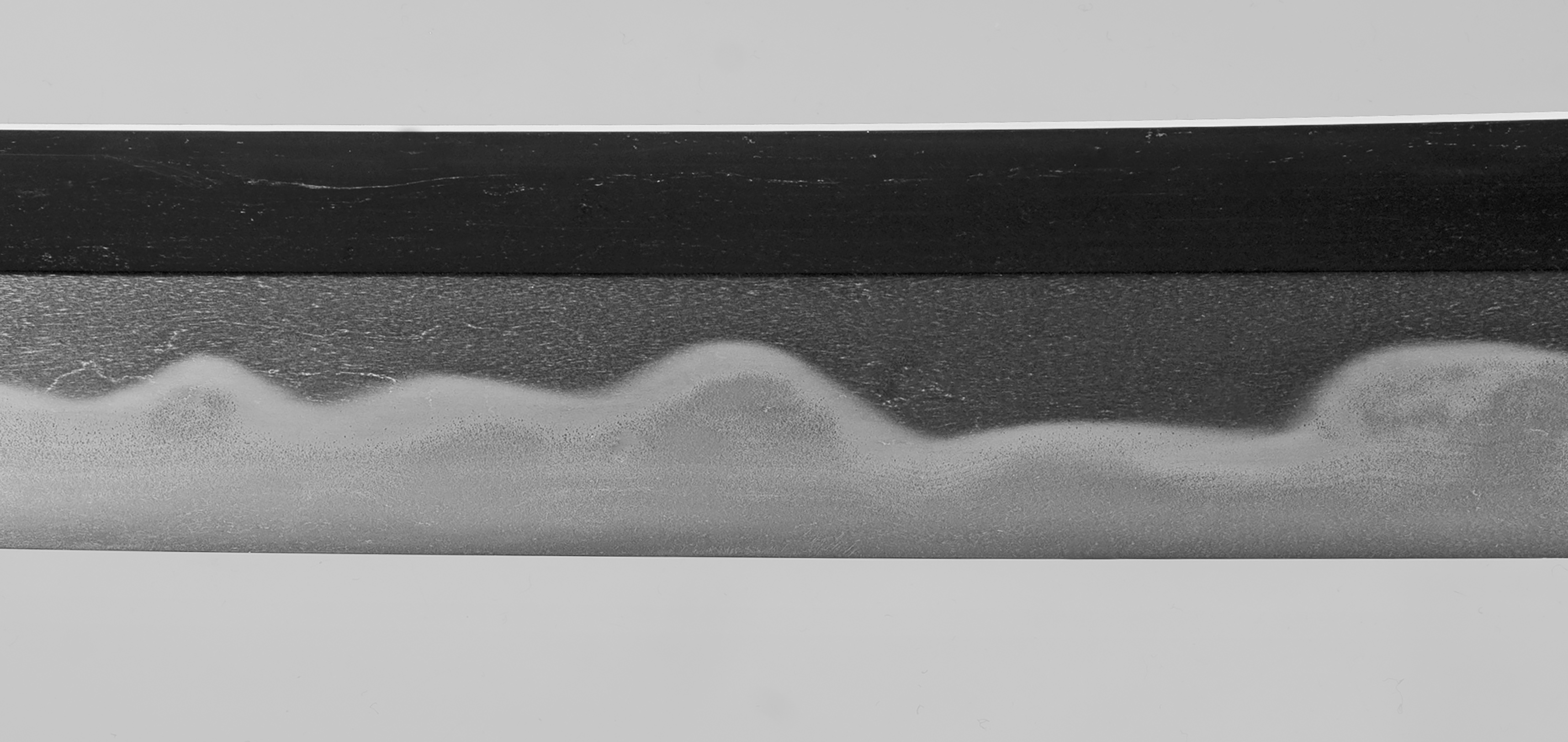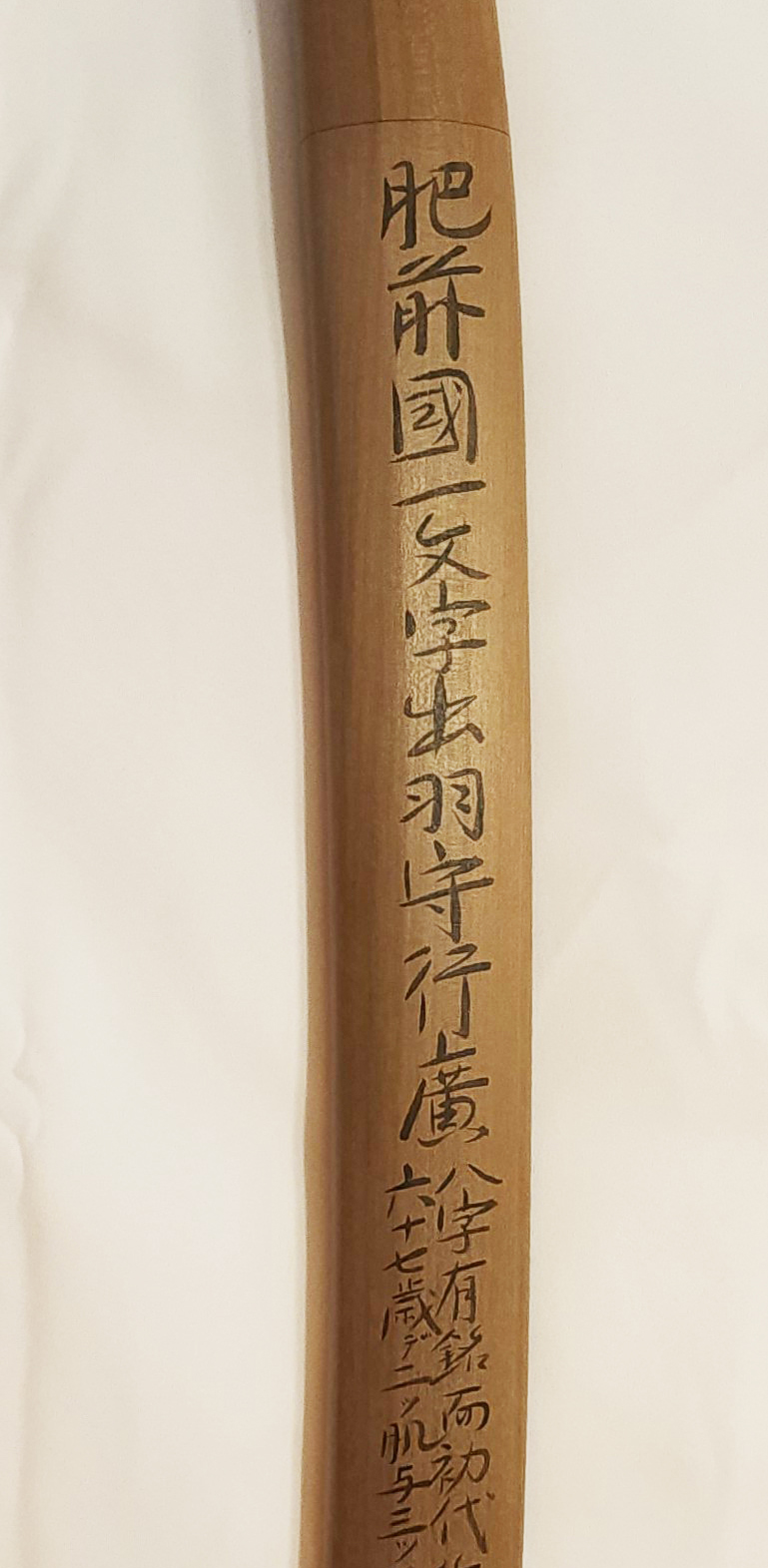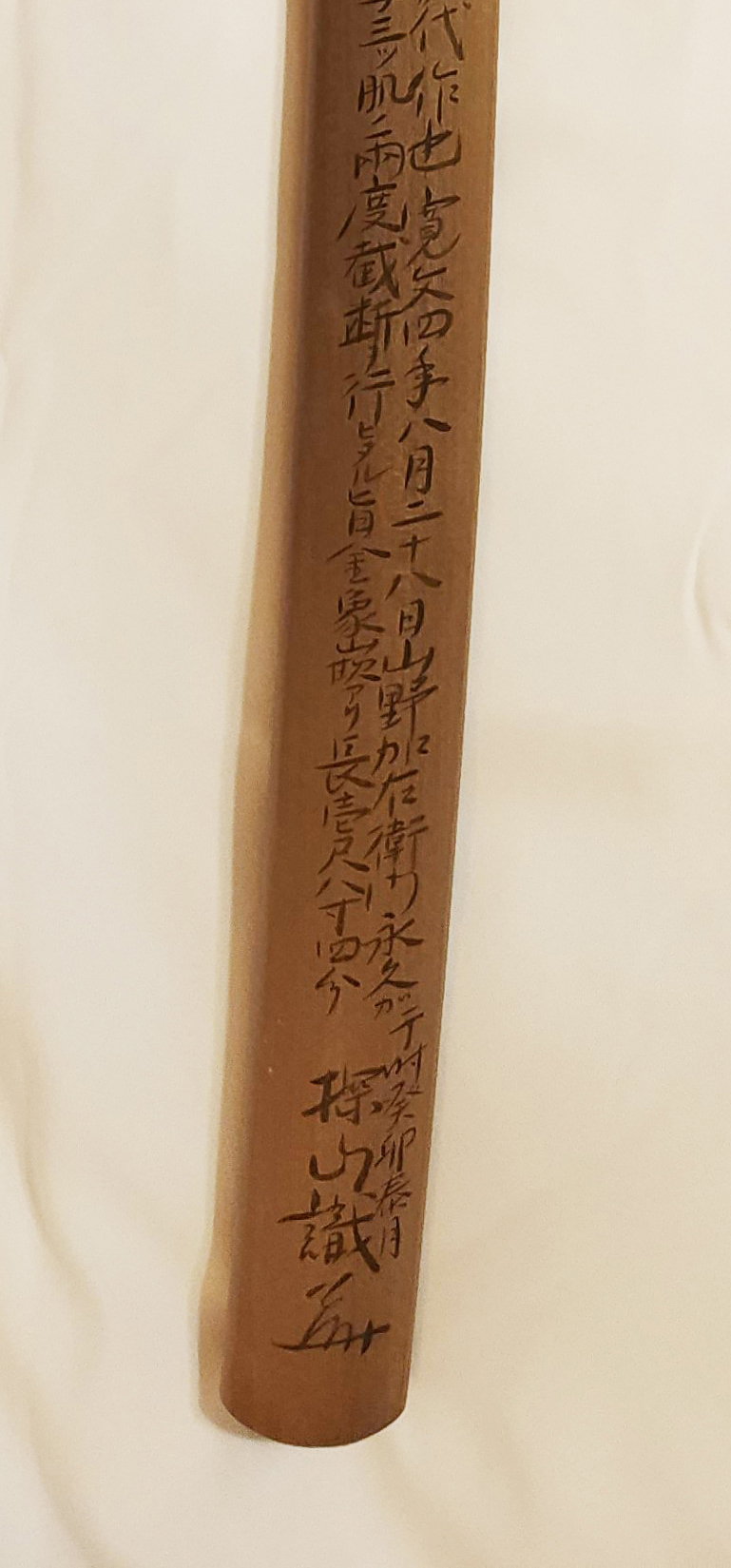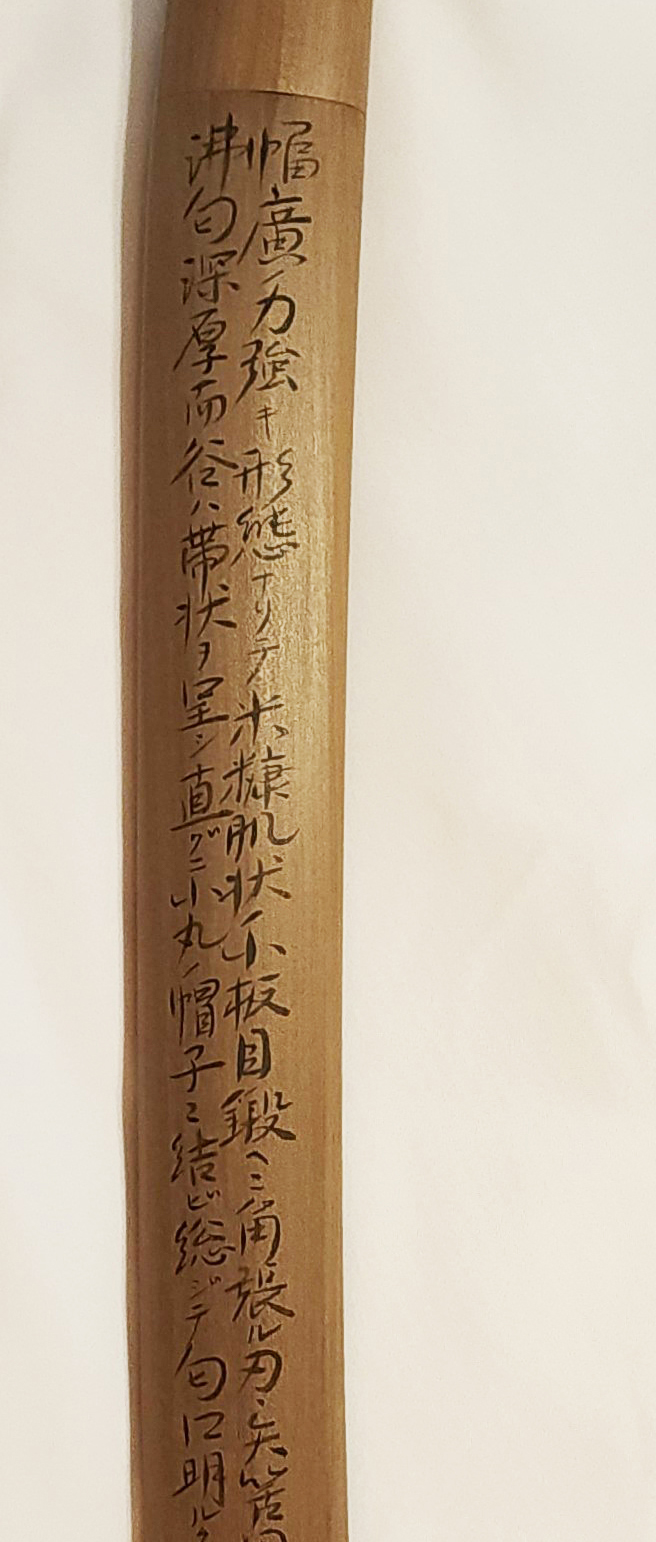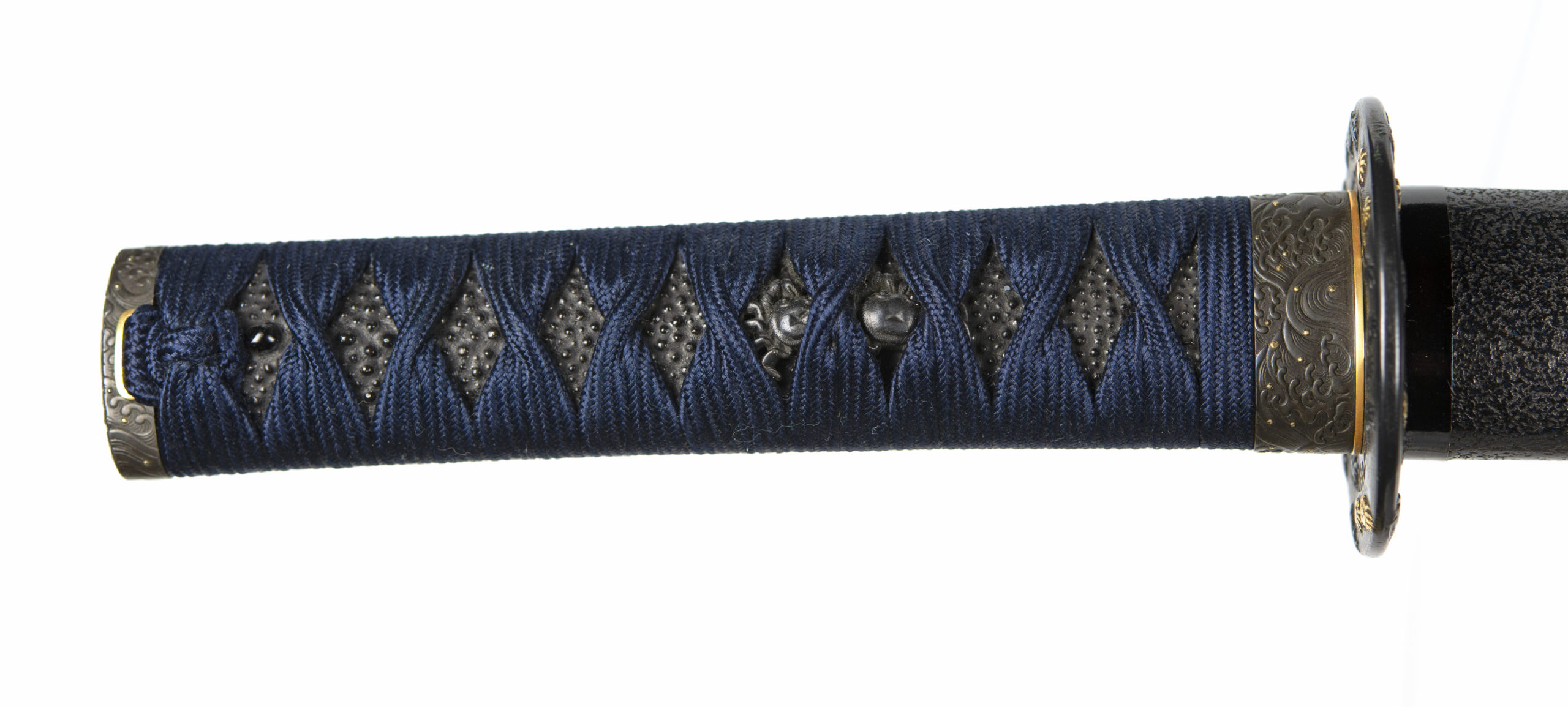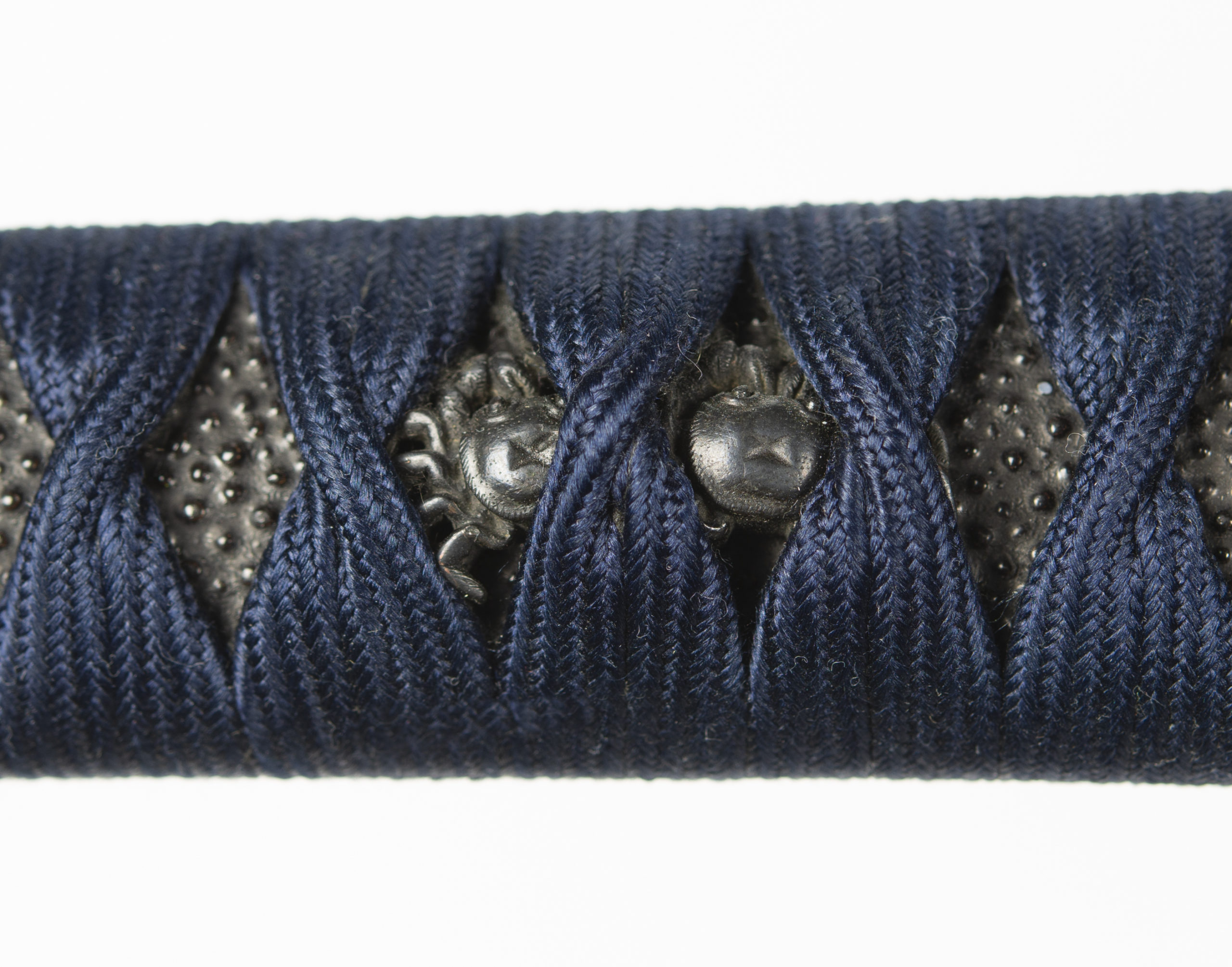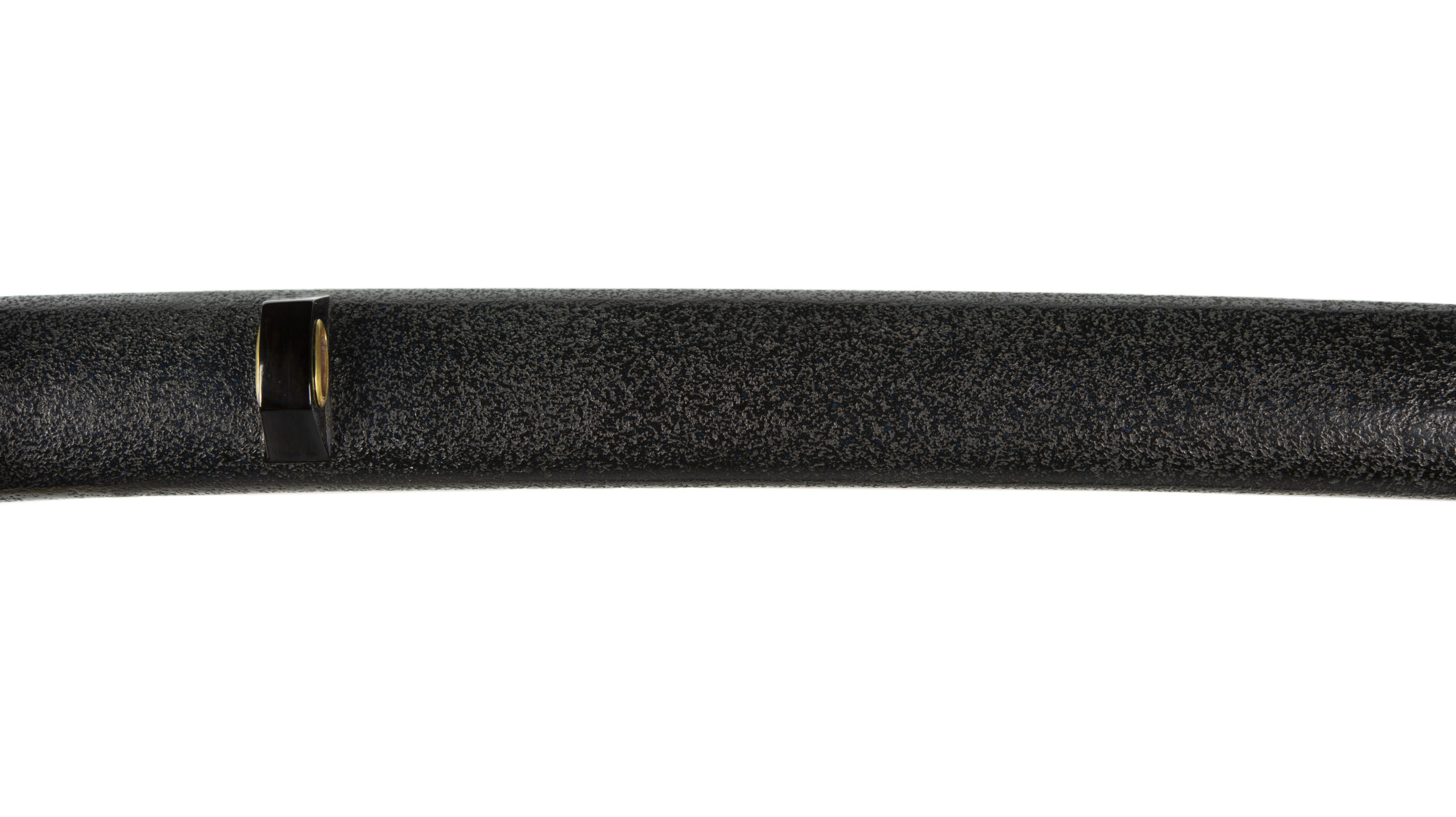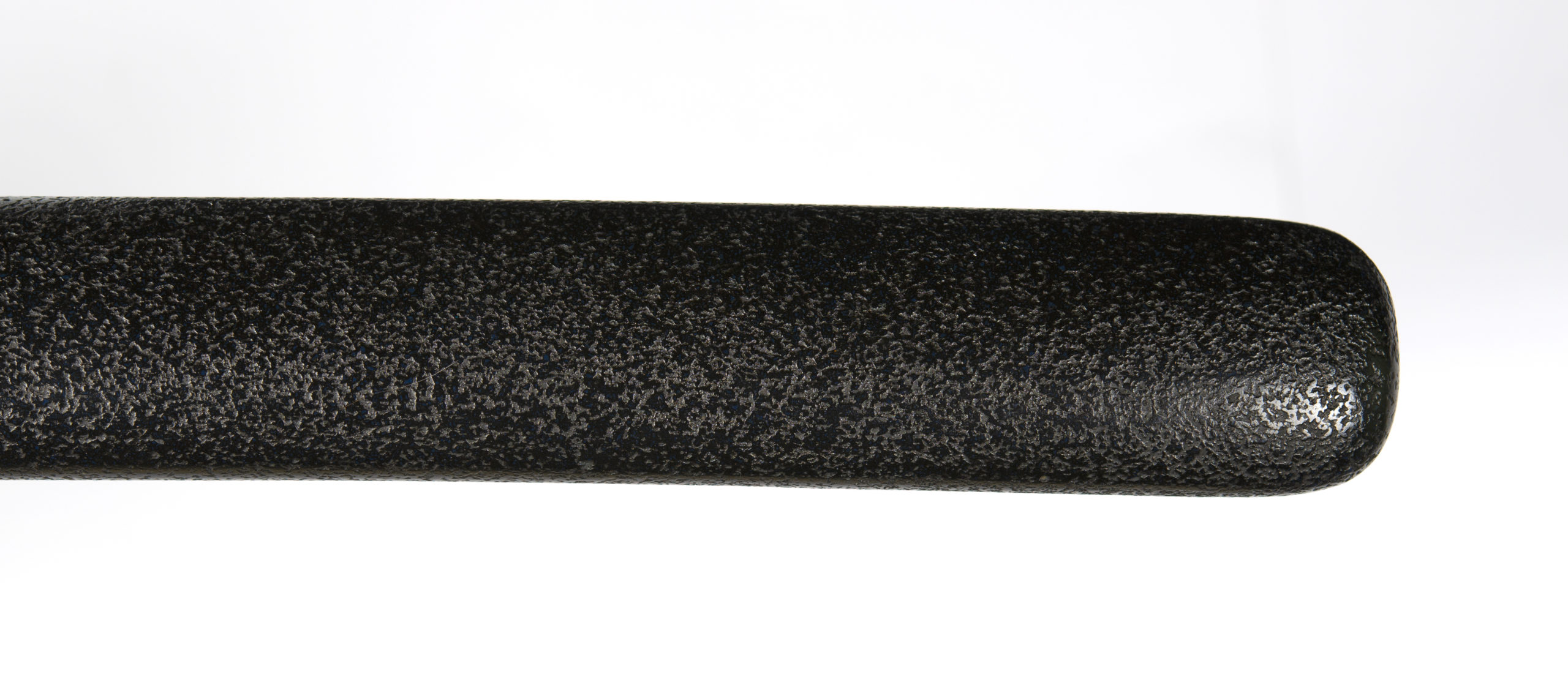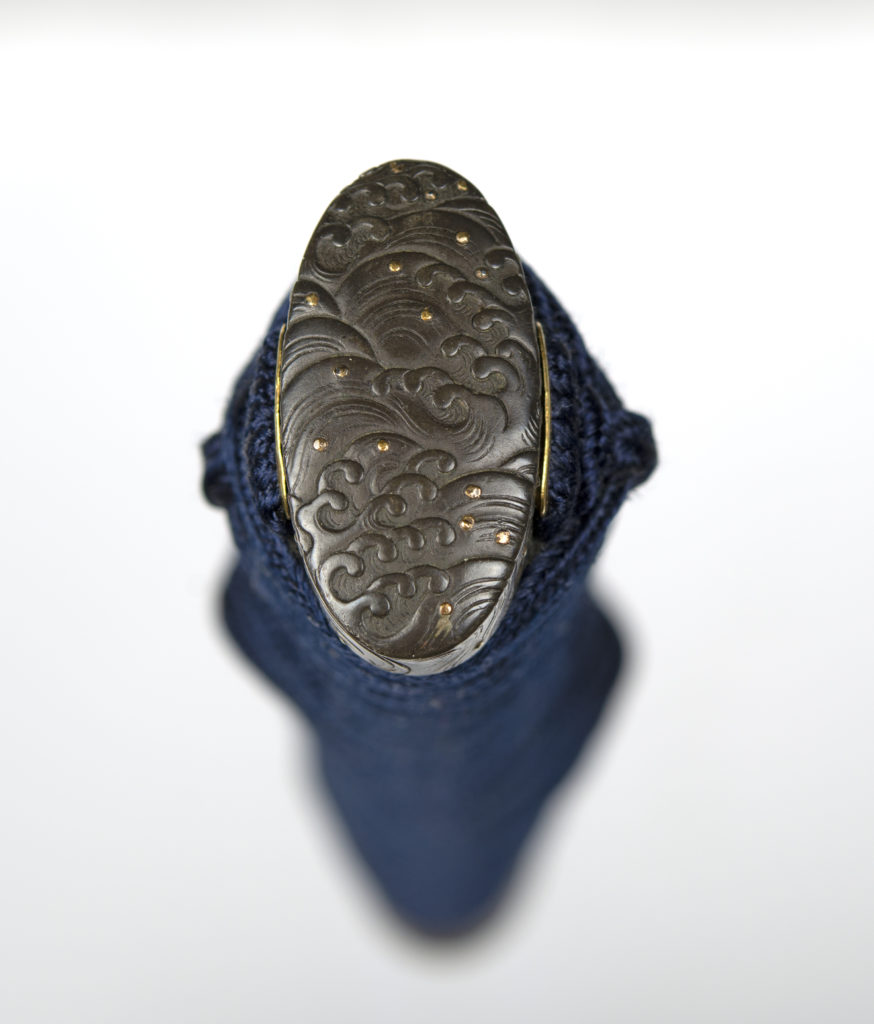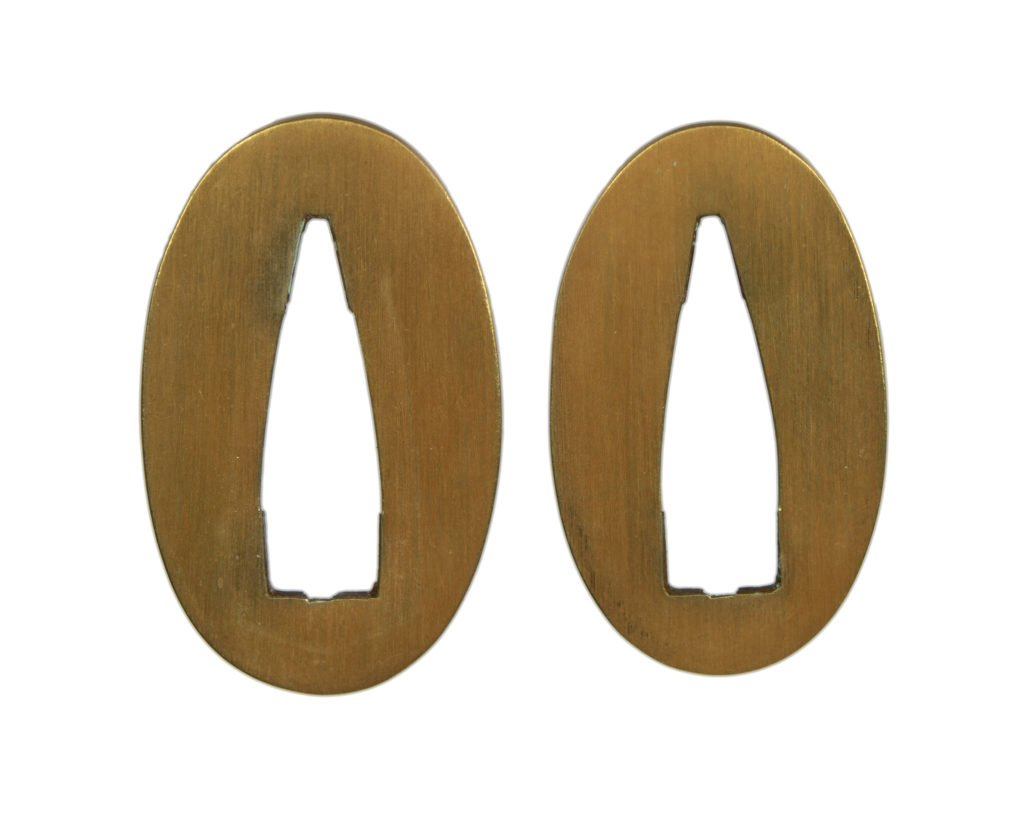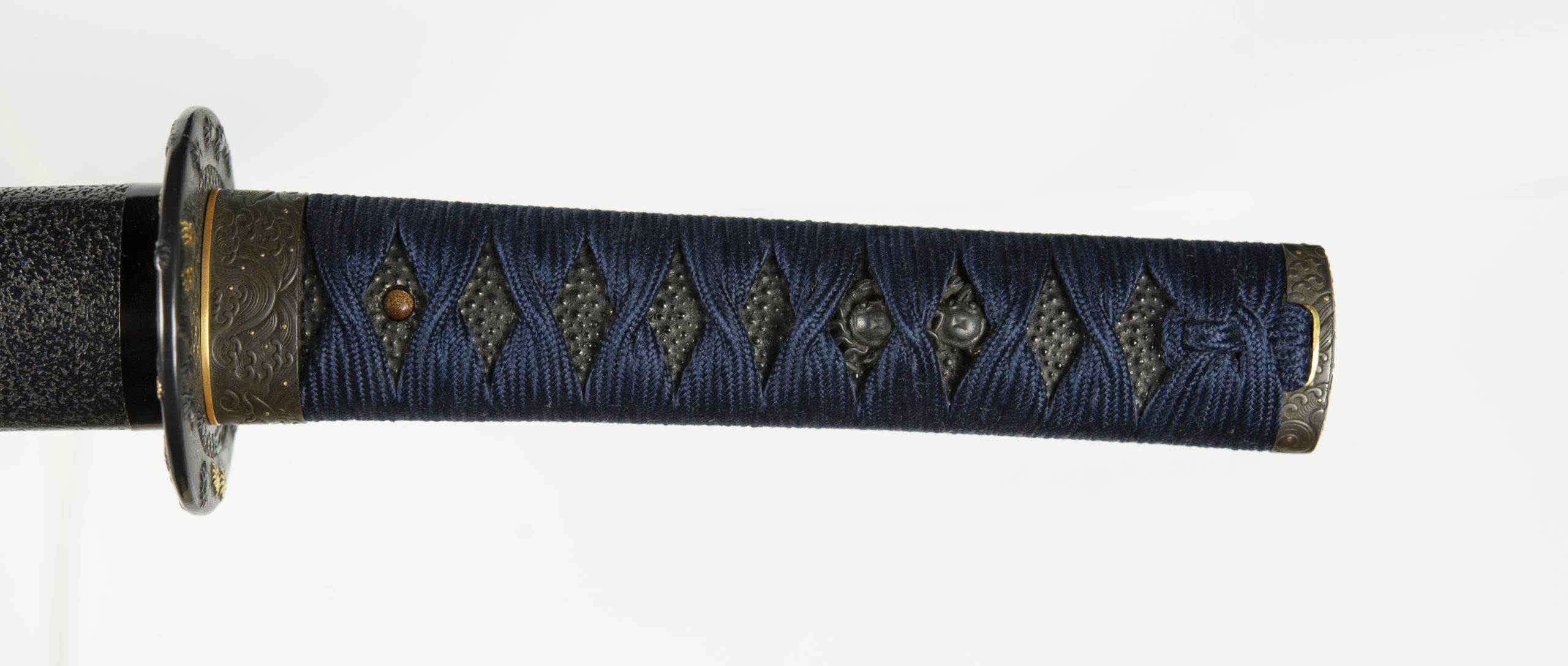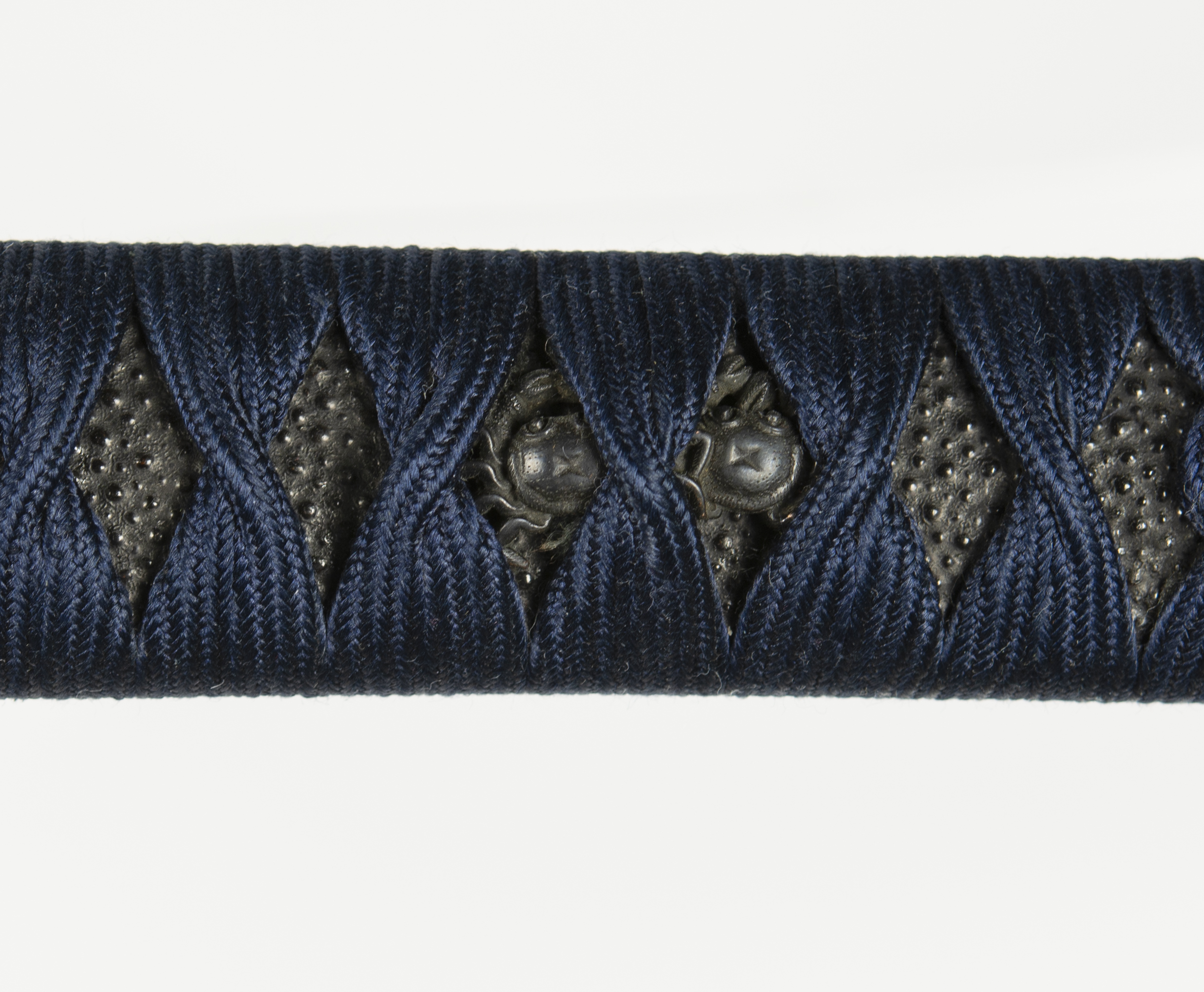See additional detail of full koshirae at the end.
Description
This is a fine wakizashi by 1st Generation (shodai) Yukihiro, born 1617 from Hizen province. Hizen province, located on the Island of Kyushu, was home to some of the most skilled and famous swordsmiths active in the Shinto period (1596-1764). Hizen swords were highly sought after due to their supreme cutting ability, balance, and durability. His first known sword was made in Kan’ei 1639 at the age of 22. He was given the title “Dewa Daijo” in 1648 then later granted the title “Dewa (no) Kami” in 1663. During the Keian 3rd (1650) he traveled to Nagasaki to study Dutch forging techniques under Yakushiji Tanenage & Hisatsugu.It is said he studied the Bizen Ichimonji techniques under Noriyoshi. This blade bears the Ichi (Ichimonji) character.
This is signed – Ichimonji Dewa no Kami Yukihiro (一文字出羽守行廣)). A wakizashi measuring at 55.7 cm nagasa [cutting edge]. Made in kanbun which ranges from 1661-1673 AD with a 2 & 3 body gold inlay cutting test done by Nagahisa August 28th, 1664, also to include a custom koshirae. We can conclude with his new title received in 1663 and date of cutting test in 1664 that this wakizashi was made in 1663 or 1664.
The blade is now stored in a new 20+ year old aged honoki, with sayagaki by Tanzan, Tanobe Michihiro sensei. The prior shirasaya (for the last 50-75 years or so) has sayagaki by 剣掃 (Kensō), otherwise known as Murakami Kōsuke, a prior board member and shinsa judge of the NBTHK, now mounted on a wooden blade (tsunagi) for preservation.
Yukihiro has an NBTHK Tokubetsu-hozon certificate, meaning Extraordinarily Worthy of Preservation. The fuchigashira, menuki and tsuba each have NBTHK Hozon certificates meaning Worthy of Preservation. There is also a 5th certificate on the blade by NTHK-NPO at the 2016 Chicago shinsa of which it scored a 78 of 100 (see scan of worksheet), during the prior ownership.
Tanobe Michihiro sensei (former Senior manager of the NBTHK’s Japanese sword museum) wrote with his sayagaki a description of this sword in his eyes.
“This blade has a wide mihaba and is of a powerful shape. It displays a kitae in ko-itame that appears as konuka-hada and is hardened in long intervals in angular and yahazu elements and chōji, that are connected via gently undulating notare sections. The ha is nie-laden and the nioiguchi is wide and appears in the typical belt shape in the valleys of the ha. In addition, the bōshi is sugu with a ko-maru-kaeri, and with the nioiguchi being bright and clear, we have here a textbook work by this smith, which is also of an excellent deki.”
At the end of Yukihiro’s career, he was serving under Nabeshima Sakyo in the town of Nagase, he passed away at the age of 66 May 27th, 1683 (Tenna 3rd). His line continued into later generations as far as the 1900’s.
In his family ranks were Shodai Hizen Masahiro (his older brother by approx 11 years), his father Yoshinobu (adopted), and his grandfather Shodai Hizen Tadayoshi. Yukihiro was known to sign his katana with tachi-mei, and his wakizashi with katana-mei (sashi-omote).
The blade was registered on September 20, 1954, in Fukuoka under the register number 22556.
Ratings:
Fujishiro’s reference: Jo Saku (Superior made)
Hawley’s: 90 points
Sharpness rating: Kokan Kaji Biko by Yamada Asaemon- rated as Wazamono (High degree of sharpness).
Toko taikan: 5.5 million Yen
Certificates: Blade- original NBTHK certificate, NBTHK Tokubetsu Hozon & NTHK-NPO, Fittings – NBTHK Hozon 3x.
This Sword is available for purchase. With serious interest please inquire for price via email or contact us at 1(608) 315-0083 telephone or WhatsApp.
Please continue to view below.
Thank you.
Signature (mei) Translation
Signature (mei) Translation :
Ichimonji Dewa No Kami Yuki Hiro
Translation of Kinzogan mei:
Yamano (Family name) Kauemon (his first name of cutter), 67 Sai (67 age) Naga Hisa (given name) Kao
Kanbun 4 year (1664) Hachigatsu (August) 28 Nichi (date of 28th)
Futatsu Dou (two body) Mitsu Dou (three body) Sai Dan (cut)
Sayagaki by Kensō. Kosuke Murakami was formerly on the board of directors with the NBTHK. In the 1980's he issued his own papers under Tōensha.
肥前國一文字出羽守行廣
刃長一尺八寸四分五厘有之但寛文四年山野截断金象嵌銘入也
昭和四拾六歳弥生中澣
剣掃「花押」
Hizen no Kuni Ichimonji Dewa no Kami Yukihiro
Hachō isshaku hassun yon-bu go-rin kore ari, tadashi Kanbun yonen Yamano setsudan kinzōgan-mei hairu nari.
Shōwa yonjūrokunen yayoi chūkan
Kensō + kaō
Ichimonji Dewa no Kami Yukihiro from Hizen Province
Blade length ~ 55.8 cm, bears a gold-inlaid result of a Yamano cutting test performed in Kanbun four (1664).
Mid-third of March of Shōwa 46 (1971)
Kensō + monogram.
Sayagaki by Tanzan, Tanobe Michihiro sensei (former Senior Managing Director) of The Japanese Sword Museum at the NBTHK.
肥前國一文字出羽守行廣
八字有銘而初代作也寛文四年八月二十八日山野加右衛門永久ガ六十七歳デニッ肌与三ッ肌截断ヲ行ヒタル旨金象嵌アリ
長壱尺八寸四分
干時癸卯泰月探山識「花押」
幅廣ノ力強キ形態ナリテ米糠肌状ノ小板目鍛ヘニ角張ル刃・矢筈風ノ刃・丁子ヲ間遠ニ焼キ其等ヲ浅キ湾レデ繋グ刃取ヲ見セ沸匂深厚而谷ハ帯状ヲ呈シ直グニ小丸ノ帽子ニ結ビ総ジテ匂口明ルク冴ヘルナド典型的作風様式ヲ示シ出来宜矣
Hizen no Kuni Ichimonji Dewa no Kami Yukihiro
Hachi-ji yūmei shikamo Shodai saku nari. Kanbun yonen hachigatsu nijūhachinichi Yamano Ka’emon Nagahisa ga rokujūnana-sai de futatsu-dō yo mitsu-dō setsudan o okonai-taru mune kinzōgan ari.
Nagasa isshaku hassun yon-bu
Toki ni mizunoe-u taigetsu Tanzan shirusu + kaō
Haba-hiro no chikrazuyoki keitai narite konuka-hada-jō no ko-itame kitae ni kakubaru-ha, yahazu-fū no ha, chōji o matō ni yaki sorera o asaki notare de tsunagu hadori o mise nie-nioi shinkō shikamo tani wa obi-jō tei-shi sugu ni ko-maru no bōshi ni musubi sōjite nioiguchi akaruku sae narudo tankei-teki sakufū yōshiki o shimeshi deki yoroshi.
Ichimonji Dewa no Kami Yukihiro from Hizen Province
This blade bears an eight-character signature and is a work of the first generation. It also bears a gold-inlaid inscription, which states that on the 28th day of the eighth month Kanbun four (1664), Yamano Ka’emon Nagahisa cut with this blade at the age of 67 through two and through three bodies.
Blade length ~ 55.7 cm
Written by Tanzan [Tanobe Michihiro] in January of the year of the hare of this era (2023) +
monogram.
This blade has a wide mihaba and is of a powerful shape. It displays a kitae in ko-itame that appears as konuka-hada and is hardened in long intervals in angular and yahazu elements and chōji, that are connected via gently undulating notare sections. The ha is nie-laden and the nioiguchi is wide and appears in the typical belt shape in the valleys of the ha. In addition, the bōshi is sugu with a ko-maru-kaeri, and with the nioiguchi being bright and clear, we have here a textbook work by this smith, which is also of an excellent deki.
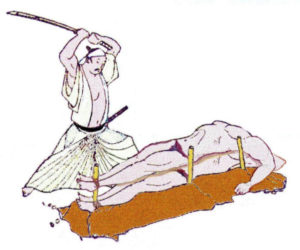
This is the most common region cut for multiple body cutting tests.
This shows example how two bodies were stacked before the cutting test

And the above image depicts the result
Briefly, the koshirae: mounted on tsunagi is in a deep blue sea theme with dark blue silk laced handle & a black-blue lacquer saya done in ishimeji style (imitations of stone). There is a gold shitodome on kurikata and kashira. The habaki is a tomoyasuri gold foil. The seppa are in a gold foil.
The tsuba: Ami-sukashi gunkai no zu tsuba (綱透群蟹図鐔) – Tsuba with openwork design of net and depicting groups of crabs. Mei: Echizen Fukui – Shichirō saku (越前福井・七郎作) “Made by Shichirō from Fukui in Echizen”. Tatemaru-gata, shakudō, ji-sukashi openwork design, takabori relief, gold iroe accents, raised dote-mimi with nanako ground. Prior owners’ description follows in quotations.” A tsuba like this one is a rare pleasure. It is a great work of his with a shakudo nanako rim covered with gold and shakudo crabs. The interior of the tsuba is an intricately carved fishing net. The tsuba quality and feeling of this tsuba is ko-kinko. “
The menuki: depicting two crabs each. They are attributed to [Gotō]* Kenjō (顕乗), they are Shakudō, katachibori crabs. *The Gotō attribution is not spelt out on the Hozon certificate; however sometimes the NBTHK omits the family name if the artist’s name is very distinctive, like in this case with the Gotō Kenjō crab menuki. Also another way the NBTHK does it, is by example, just Sōmin for Yokoya Sōmin.
Reference from chapter 2.7 Gotō Kenjō (後藤顕乗), 7th gen. in the book by Markus Sesko, The Japanese tōsō-kinkō Schools: Kenjō´s civilian names were Masatsugu“ (正継), „Mitsuha“ (光派) and „Mitsutsune“ (光経) and his first names were „Gen´ichirō“ (源一郎) and „Ribei“ (理兵衛). He was born in the 14th year of Tenshō (1586), the second son of Tokujō. After the relatively early death of his older brother Eijō he succeeded as head of the family and as the 7th gen. mainline. Together with his cousin Kakujō (覚乗) he worked on a biennial basis alternating between Kyōto, for the bakufu, and Kanazawa (金沢) for the Maeda family (前田) who were the daimyō of Kaga province. Kenjō died on the 22nd day of the first month of Kanbun three (1663), at the age of 78.
The fuchigashira: signed Kikuchi Tsuneoki + kaō (菊池序沖「花押」). Tsuneoki was the second master of the Kikuchi lineage. Well-made Shibuichi, sukidashibori relief, spray in gold inlay, iroe accents.
Reference from 24.2 Kikuchi Tsuneoki (菊池序沖), 2nd gen.,. in the book by Markus Sesko, The Japanese tōsō-kinkō Schools: Tsuneoki was the son of Tsunekatsu and followed him as 2nd gen. of the Kikuchi family. Some sources list the later mentioned Tsunemitsu (序光) as 2nd gen. but the „Sōken-kishō“, which was published during his lifetime, says that he was a student of Tsunekatsu. That means this information should be correct. However, the „Tōsō-kodōgu-kōza“ lists Tsunemitsu as a student and later adopted son and successor of Tsunekatsu. But Tsuneoki´s first name was „Seijirō“ (清二郎) which is seen by some as support of him as having been the 2nd gen. Kikuchi.
Tsuneoki signed first with Masamitsu (政光) and later also with Masakatsu (政克) but it is not yet completely clarified if Kikuchi Masakatsu was a different kinkō than Tsuneoki. The „Tōsō-kodōgu-kōza“ even assumes that Masakatsu was the younger brother of Tsunekatsu and had therefore nothing to do with Tsuneoki. Anyway, Tsuneoki is said to have been the student of Inagawa Naokatsu. He used the gō „Sōju“ (草寿) and „Sōjuken“ (草寿軒) but more details about his career or his year of birth and death are largely unknown.
The tsuka: a dark blue silk lacing, beneath is samegawa nuri (rayskin lacquered black) a very desirable method that highlights the crab menuki well.
Blades certificates images and translation:
NBTHK Tokubetsu Hozon certificate and translation.
Kantei-Sho (鑑定書) – Appraisal
No 1001464
Wakizashi, signed: Ichimonji Dewa no Kami Yukihiro (1st gen.) (一文字出羽守行弘「初代」)
Kinzōgan-mei : Kanbun yonen hachigatsu nijūhachinichi – Yamano Ka’emon rokujūnana-sai Nagahisa + kaō – Futatsu-dō mitsu-dō setsudan (寛文四年八月廿八日・山野加右衛門六十七歳永久「花王」・二ツ胴三ツ胴截断) – “Yamano Ka’emon Nagahisa cut [with this blade] on the 28th day of the eighth month of Kanbun four (1664), and at the age of 67, through two and through three bodies”
nagasa ~ 55.7 cm
According to the result of the shinsa committee of our society, we judge this work as authentic and rank it as Tokubetsu-Hozon Tōken.
August 15, 2013
[Foundation] Nihon Bijutsu Tōken Hozon Kyōkai, NBTHK (日本美術刀劍保存協會)
NTHK npo certificate, worksheet & translation.
kantei-sho (鑑定書) – Certificate
wakizashi (脇指)
Hizen, Shodai Dewa no Kami Yukihiro (肥前、初代出羽守行廣)
shôshin (正真) – Authentic
nagasa 1 shaku 8 sun 4 bu kore ari (長さ一尺八寸四分有之) – Blade length ~ 55.7 cm
Heisei 28 nen 2 gatsu 26 nichi (平成二十八年二月二十六日) – February 26th 2016
Non Profit Organization (特定非営利活動法人)
Nihon Tôken Hozon Kai (日本刀剣保存会) – NTHK
Board Chairman (理事長): Miyano Teiji (宮野貞司)
No T. 160089
meibun (銘文) – Signature: Ichimonji Dewa no Kami Yukihiro (一文字出羽守行廣)
kinzôgan-mei: Kanbun yonen hachigatsu nijûhachinichi (寛文四年八月二十八日,
“28th day of the fourth month Kanbun four [1664]”) Yamano Ka’emon rokujûnanasai Nagahisa + kaô (山野加右衛門六十七歳永久, “Yamano Ka’emon Nagahisa, age 67 + kaô”)
Futatsu-dô mitsu-dô setsudan (二ッ胴三ッ胴切断, “cut through two and three bodies”)
tsukurikomi (造り込み) – Shape: shinogi-zukuri, iori-mune
kitae (鍛) – Forging: fine ko-itame
hamon (刃紋) – Hardening: flamboyant ô-gunome-midare that varies in width and that is
mixed with tama and tobiyaki
bôshi (鋩子) – Hardening in tip: sugu with a ko-maru-kaeri that runs back to about the height of
the yokote
chôkoku (彫刻) – Engravings:
nakago (中心) – Tang: mekugi-ana (目釘穴) 1, yasurime (鑢): ô-sujikai
bikô (備考) – Remarks: around Kanbun (1661-1673)
shinsa’in natsu’in (審査員捺印) – Seals of Judges: 4 seals
Fittings (Tosogu) certificates images and translation:
NBTHK Hozon certificate and translation.
Kantei-Sho (鑑定書) – Appraisal
No 4003643
Ami-sukashi gunkai no zu tsuba (綱透群蟹図鐔) – Tsuba with openwork design of net and depicting groups of crabs
Mei: Echizen Fukui – Shichirō saku (越前福井・七郎作)
“Made by Shichirō from Fukui in Echizen”
Tatemaru-gata, shakudō, ji-sukashi openwork design, takabori relief, gold iroe accents, raised dote-mimi with nanako ground
According to the result of the shinsa committee of our society, we judge this work as authentic and rank it as Hozon Tōsōgu.
November 1, 2013
[Foundation] Nihon Bijutsu Tōken Hozon Kyōkai, NBTHK (日本美術刀劍保存協會)
NBTHK Hozon certificate and translation.
Kantei-Sho (鑑定書) – Appraisal
No 4008822
Hatō no zu fuchigashira (波濤図縁頭) – Fuchigashira depicting waves
Mei: Kikuchi Tsuneoki + kaō (菊池序沖「花押」)
Shibuichi, sukidashibori relief, spray in gold inlay, iroe accents
According to the result of the shinsa committee of our society, we judge this work as authentic and rank it as Hozon Tōsōgu.
January 15, 2016
[Foundation] Nihon Bijutsu Tōken Hozon Kyōkai, NBTHK (日本美術刀劍保存協會)
NBTHK Hozon certificate and translation.
Kantei-Sho (鑑定書) – Appraisal
No 4002773
Nihiki kani no zu menuki (二疋蟹図目貫) – Menuki depicting two crabs each
Mumei: Kenjō (顕乗)
Shakudō, katachibori
According to the result of the shinsa committee of our society, we judge this work as authentic and rank it as Hozon Tōsōgu.
June 27, 2013
[Foundation] Nihon Bijutsu Tōken Hozon Kyōkai, NBTHK (日本美術刀劍保存協會)
*The Gotō attribution is not spelt out above; however sometimes the NBTHK omits the family name if the artist’s name is very distinctive, like Gotō Kenjō. For example just Sōmin for Yokoya Sōmin.
Gallery of additional images in high resolution
Close-up @ 150%
Close-up @ 200%
Following are macro HR detail shots @150%
This Sword is available for purchase. With serious interest please inquire for price.
If you wish to purchase contact us directly via email or contact us at 1(608) 315-0083 any time.
Pictures and content may not be copied without the express permission of samuraisword.com ©






